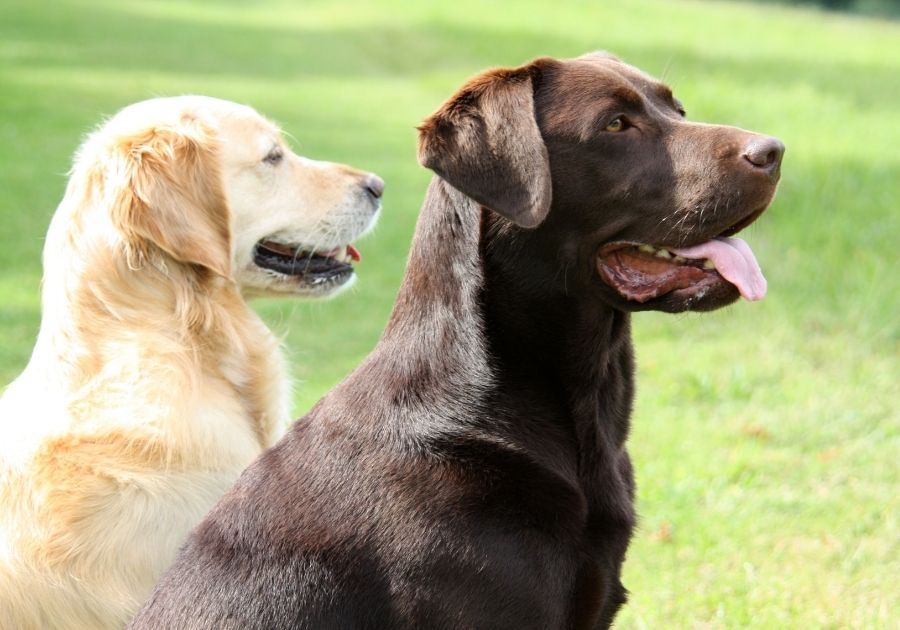Who doesn’t know these Retriever types duo? Two of America’s favorite breeds, the Labrador Retriever and Golden Retriever have always been at the Top 5 on the list of popular dog breeds, and for good reason.
They have all it takes to be good household pets, and have been that for years.
Labradors and Goldens look alike, so much that it can be hard to tell them apart. They also share similar temperaments and were initially bred to play the same role.
That said, they are distinct breeds with some differences.
If you’re not sure which to get as a companion, a comparison of the similarities and differences between Labrador Retriever and Golden Retriever can help.
This article holds the answer you seek regarding the Labrador Retriever vs Golden Retriever.
With detailed explanations, you will get to learn more about both breeds and the factors that set them apart.
Labrador Retriever vs Golden Retriever: General Facts

| Facts | Labrador Retriever | Golden Retriever |
|---|---|---|
| Height | 21 to 25 inches | 21 to 24 inches |
| Weight | 55 to 80 pounds | 55 to 75 pounds |
| Coat Type | Double, wiry, soft | Double, dense, thick |
| Coat Colors | Black, chocolate, yellow | Gold, cream |
| Temperament | Kind, agile, intelligent | Friendly, kind, trustworthy |
| Trainability | High | High |
| Life Expectancy | 10 to 12 years | 10 to 12 years |
| Energy | High | High |
| Good First-time Dogs | Yes | Yes |
| Good with Kids | Yes | Yes |
| Good for Apartments | No | No |
| Good for Family | Yes | Yes |
| Shedding | High | High |
| Barking/Howling | High | High |
Labrador Retriever Dog Breed Overview

Labrador Retriever History
The Labrador Retriever started as St John’s Dog and originated in Newfoundland, a Canadian Island.
It was first named from the capital of Newfoundland and was developed to work alongside fishermen.
They retrieved fish, grabbed ropes, and were the assistants of these men. After a day’s job, they got back to being companions for the fishermen’s families.
The name switch from St John’s Dog to Labrador Retriever happened in the 19th century when the breed got into the United Kingdom.
The third Earl of Malmesbury was credited for the new name, which stuck till today.
It might not seem so with the long-standing fame, but the Labrador Retriever faced extinction in the same 19th century.
It disappeared in Newfoundland but was saved in England where it flourished. The Kennel Club recognized the Labrador in 1903 and the American Kennel Club followed in 1917.
The Labrador Retriever is currently the most popular dog breed in the United States for the 31st time—it remains unrivaled.
Labrador Retriever Appearance
Labradors are medium to large dog breeds with the males being bigger than the females.
The male Lab has a height range of 23 to 25 inches while the female Lab grows between 22 to 24 inches. In weight, male Labs are usually 10 pounds heavier than the females.
Labs are stocky, though some have a slimmer frame. They have wide heads, large eyes, floppy ears, and a black nose sitting at the center of the face.
The coat is double. The outer coat is short, thick, and straight while the undercoat is soft and waterproof.
Labrador Retriever Personality
The Labrador is a package of beautiful personalities. Its sweet nature endears many pet parents to it, a major reason it keeps topping the list.
This outgoing breed is sure to greet every visitor with enthusiasm! Don’t count on it to be a guard dog. It might end up befriending the intruder.
Besides its outgoing nature, the Labrador is also willing to please and easy to train, provided you can handle its exuberant nature.
This breed is highly energetic and needs a lot of exercise, making it an unsuitable choice for an apartment.
Altogether, the Labrador makes a good family dog. It loves kids and would love to be around them.
It’s not uncommon to see your Labrador outdoors participating in games. It is also good with other dogs and pets.
Golden Retriever Dog Breed Overview

Golden Retriever History
The Golden Retriever originated in Scotland, regardless of the legend that it was a descendant of Russian sheepdogs.
It was developed in the estates of a man named Sir Dudley Majoribanks, also known as Lord Tweedmouth.
His goal was to get a good retriever for his waterfowl hunting with a lovely personality. From that goal, the Golden Retriever emerged.
The main ancestor of the Golden Retriever was a Flat-Coated Retriever named Nous.
It was unique in that it had a yellow coat, unlike its black-coated siblings.
In the late 19th century, Tweedmouth bred Nous to a Water Spaniel named Belle.
Further matings occurred to get the first of what we now know as Golden Retrievers.
The Kennel Club recognized the Golden Retriever in 1911 and had the name “Retriever—Yellow or Golden”.
It changed in 1920 to Golden Retriever. In 1932, the American Kennel Club recognized the breed.
Golden Retriever Appearance
Goldens are well known for their distinct gold color and are medium to large dogs. Similar to many other dog breeds, the male Golden is bigger than the female.
The male weighs between 65 and 75 pounds with a height of 23 to 24 inches. The female weighs 55 to 65 pounds and usually maxes at 23 inches.
This breed has droopy ears, a long muzzle, a black nose, and a face that makes you think of a big puppy.
Its double coat comprises a dense and waterproof outercoat with a thicker undercoat.
Golden Retriever Personality
Golden Retrievers make one of the best family dogs and are good for first-time dog parents.
Its calm and sweet nature is its trump card, and it is a people pleaser. Golden Retrievers is also playful and a social butterfly.
Because it takes time to mature, expect to have a puppylike pooch for a longer time compared to other breeds.
Golden is also loyal and intelligent, but don’t imagine it can be either a watchdog or a guard dog. It does poorly in both.
It isn’t a lazy, indoor breed, though. As a Sporting Dog, the Golden Retriever loves to work and thrives where it has work to do.
Notwithstanding its sweet nature, Goldens should be trained like every other dog. Neglecting that would make it develop bad habits like excessive howling.
Similarities and differences between Labrador Retriever and Golden Retriever

With their similar looks, behaviors, and historical roles as retrievers, it feels like you can interchange the Labrador with the Golden (and vice versa).
Technically, that could be possible as they both act as excellent companions and workers in homes. But like any dog lover would know, each breed is unique.
Here are the similarities and differences in some common areas.
Size
The Labrador Retriever and Golden Retriever are both medium to large-sized dogs and you might even pick two members of each breed and find that they have uniform sizes.
On a general level, however, the Labrador Retriever tends to be bigger than the Golden Retriever.
The difference isn’t much (1 inch in height, 5 pounds in weight) but it is enough to count as a difference.
Those who prefer smaller and more manageable dogs may find both the Labrador and Golden sizes to be a bit overwhelming. They aren’t too large, though, but require space.
Energy

Both the Labrador Retriever and Golden Retriever are workers, so they have high energies and need regular exercise.
The Golden Retriever is calmer, however, and doesn’t get restless as fast as the Labrador Retriever.
It is a small difference, though, as they are both energetic dogs with a need for space and enough activities.
What’s even cooler is that they enjoy similar activities. Fetch and any game that involves retrieving an object are their favorites.
Labradors tend to love swimming more than Goldens, but they both do well with water.
They are also intelligent dogs and might get bored if mentally understimulated.
Thus, they should not be limited to physical activities alone. Mental activities are important as well.
Temperament
There is no major difference in the personalities and behaviors of the Labrador and Golden Retriever.
The only distinction stems from the energy level. Though we pointed out that they are both unsuitable for apartments, Goldens would have a better chance at coping in an urban building than Labradors.
The Golden becomes calm and mellow after its daily exercise, but it takes a lot to slow down the Labrador.
Having said that, they are both sweet, friendly, and outgoing breeds. They are also affectionate and willing to please, loving addition to households.
Labradors tend to mature faster than Goldens, but they are playful.
It isn’t surprising that there are so many mixed breeds of these two, such as the Labradoodle and the Goldendoodle. Breeders always want to replicate their good dispositions.
If you can handle an energetic dog breed, then you could go for the Labrador.
First-timers with no love for hyperactive breeds might find the Golden Retriever to be more manageable.
Trainability
The Labrador Retriever and Golden Retriever are both suitable for new pet parents because of their lovely personalities and eagerness to please.
They are highly trainable, one reason they are employed to be guide dogs for the visually challenged.
Do not presume their good behaviors and ignore training and socialization. Your Lab and Golden can become nuisances if you don’t train them enough.
Start from puppyhood to teach them basic commands. Socialize them as well to avoid future timidity and anxiety.
Health and Life Expectancy
The Labrador Retriever and Golden Retriever both share similar life spans (10 to 12 years) and are both regarded as healthy dogs.
However, they are both vulnerable to certain conditions.
One illness these breeds can fall prey to is Progressive Retinal Atrophy. Also abbreviated as PRA, it is an incurable eye disease caused by the gradual destruction of the affected dog’s retina, leading to blindness.
Another common Labrador and Golden Retriever health issues is hip dysplasia, an inherited, joint-related condition that limits a dog’s movement.
Hip dysplasia is caused by the abnormal structure of the hip joint and is a cause of lameness.
Exercise-induced collapse is another illness on our list that both the Golden Retriever and Labrador can suffer from. It isn’t as common as the above-mentioned ones, but it can be serious.
Just as it sounds, exercise-induced collapse happens when either a Lab or a Golden has overexerted itself.
Though both breeds are energetic, you should control their exercise level so they don’t go beyond.
The last illness is more prevalent in the Golden Retriever than the Labrador, and that is cancer.
According to research done on the subject, about 60% of Golden Retrievers are prone to cancer. That’s a sad majority.
Golden Retrievers with cancer in their genes should not be bred. You should ask for the medical history of the parents of any Golden pup you wish to get.
Coat and Grooming

These two breeds have double coats with similar textures and styles. However, the coat colors mark their first huge difference.
The Labrador has 3 standard colors: black, chocolate, and yellow. There exist some White Labradors, but these are recognized as lighter shades of yellow.
The Golden Retriever’s main color is gold, with different shades of it. You might also find some cream.
Both breeds are shedders and require more brushing during those periods.
On an average level, the Golden Retriever has a higher grooming need because it requires more brushing and even bathing.
Do not over bathe either of them, though, or you risk removing the natural oil on the skin.
Feeding
Both the Labrador and the Golden require good, high-quality meals filled with protein.
They should be fed about 3 cups a day as adults. The brands you pick should fit their age, size, and activity level.
These dogs like food, but the Labrador is more food motivated than the Golden and more likely to gain weight. In either case, regulate their meals.
Price

The Labrador is, on average, more expensive than the Golden Retriever. This could be as a result of its popularity.
Labrador Retriever puppies usually cost between $1,000 and $2,500 while the Golden Retriever puppies cost between $1,000 and $1,300.
Both are easy to find and have their merits and demerits.
Because of their popularity, the chances of getting an ill-bred pup are higher. Shop from a reputable breeder, or you go for adoption.
You Might Also Ask
Are Labradors the same as Golden Retrievers?
Though they look alike, the Labrador is not the same as the Golden Retriever, neither are they types of the same breed. These are two different breeds.
Which is more intelligent between Golden Retriever and Labrador Retriever?
Both breeds are known to be highly intelligent, but according to research, the Golden Retriever tends to be smarter.
It is regarded as the 4th smartest breed, while the Labrador Retriever is the 7th.
Which is better between Labradors and Golden Retriever?
It is hard to tell which is better between the Labrador Retriever and the Golden Retriever.
At the end of the day, it all boils down to preference. Both breeds make good family dogs and have sweet personalities.
Are Golden Retrievers bigger than Labradors?
The Golden Retriever and the Labrador are both medium to large dog breeds, but the Labrador is bigger than the Golden.
Labrador Retriever Vs Golden Retriever – The Verdict
With fans of these types of retrievers, the differences don’t matter.
Whichever breed you go for as a pet, you’re sure to get a worthy family companion that you would always want to have close to you.
The main differences fall in the area of grooming and energy, and those are the only factors that may influence a pet parent’s decision.
That said, our verdict is that neither the Golden Retriever nor the Labrador Retriever is better than the other.







